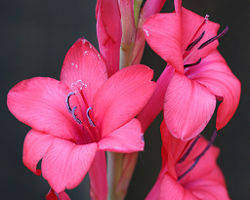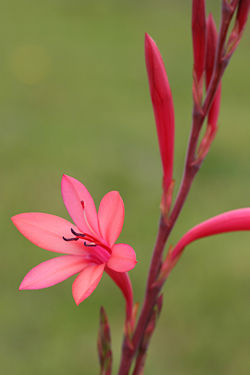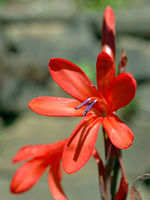Bugle lily
| Bugle lily |
|---|

|
| Scientific Classification |
|
| Species |
|
The Bugle-lily is an ornamental flowering plant belonging to the taxonomic genus Watsonia. It is native to South Africa, but has become naturalized around the wetlands and rivers in Australia, and is also can now be found in Orange County, California. They don't need good soil so they will normally be found in dry, rocky areas or in places that have just been burned down by a fire.
Anatomy
The bugle-lily is a perennial that blooms during spring and early summer. It is also a bulbous plant that roots is a bulb deep in the ground. It is a deciduous plant that grows during fall, winter, and spring, it will, also, remain dormant during late summer right after it flowers. It will grow to about two meters tall with a rootstock of about thirty to forty millimeters around that have grey-brown tunics. The Watsonia will get about eight wide, sword- shaped leaves that have a glossy look to them. The leaves will grow to about twenty to frothy millimeters wide and will be one to two thirds the size of the flower spike. The leaves will also grow very thick and without color around the edges of the leaf. And it will also grow five to six fans around the rootstock that will grow up right.
The flowering part of the Watsonia is called the spike, that can grow up to two meters and it will hold about twenty flowers. And the branching part will hold to about ten flowers. The Bugle-lily has large flowers that will be pinks, whites, and red colors. The flower can be divided into equal halves making it zygomorphic. The flowers have a very faint fragrance to them. The fruit of the Wtsonia plant is a oblong capsule that is a woody plant that can split down the middle to release the seeds of the plant. The seeds that are released are winged and are eight to twelve x 2.5 millimeters in size.[1]
Reproduction
The main way Watsonias will reproduce is by bees because they don't produce very much nectar. But the nectar they do produce will attract a lot of bees to the point where a whole bee colony will move in. They will only move in for the afternoon. It starts with the plant opening up it's flower and will last only till afternoon. The bees go plant to plant spreading it's pollen and nectar on every watsonia around.[2] The watsonia will only bloom during early summer and spring, but will remain dormant during the late summer, but will start growing during fall, winter, and some of spring. [3]
Ecology
After major fires you will find many Watsonia's that is why they are found in dry areas. But they will only be there the first year or two; than it will be able to produce lots and lots of seeds. The Bugle-lily will help out the burnt area because all of the animals can live off of it until new plants grow it. Because it will provide seeds for rodents and birds and it will also produce nectar for insects, birds, and some birds, but not for long because it does not produce very much nectar. Watsonias also are a big help to bees because early in the morning bees will move in to get the nectar produced by the plant. They will keep coming back and coming back until there is none left and there can be any left by noon. The bees come so early because that is when the plan will open and start giving off all of it's pollen.[4]
Habitat
The Bugle-lily is a native to South Africa, but has been moved to Australia because of the wet lands, gardens, and along rivers. But only six species have been naturalized to the South- West of Australia. There are only fifty-two species of Watsonia plants in South Africa and they have had to adapt to Mediterranean climate. Many people have crossed Watsonias with other types of Watsonias to create some that can live in the states or anywhere else. [5] Watsonias are found in the rocky slopes of the very southwest of the Western Cape. From Tulbagh south to Cape Peninsula and east to Bredasdorp is where you can find them in rocky slopes or in sand stone slopes or very dry areas of granite and limestone. They are always found in dry areas and will also be found at the dry part of the foot of mountains.[6]
Gallery
 Browse |
References
- Watsonia borbonica Goldblatt.
- Watsonia (Plant) Wikipedia, the free encyclopedia.
- Watsonia borbonica 'Flamboyant' San Marcos Growers.






